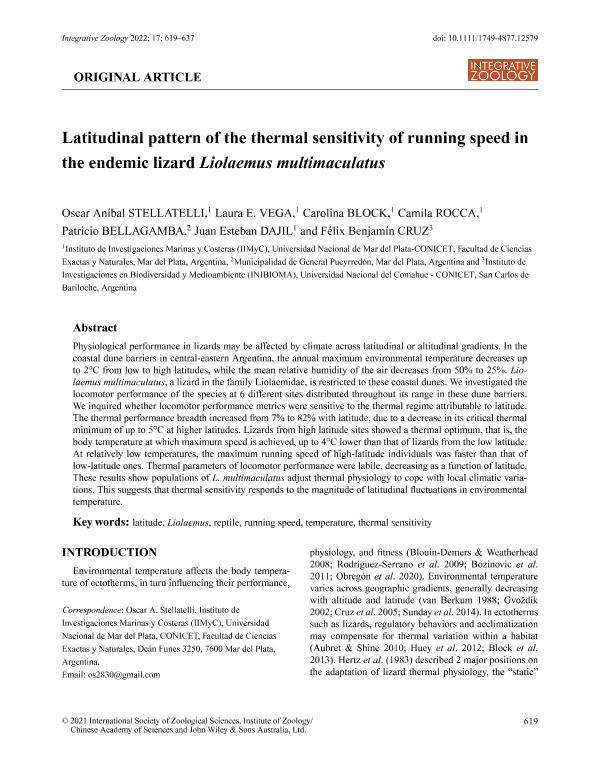Mostrar el registro sencillo del ítem
dc.contributor.author
Stellatelli, Oscar Aníbal

dc.contributor.author
Vega, Laura Estela

dc.contributor.author
Block, Carolina

dc.contributor.author
Rocca, Camila

dc.contributor.author
Bellagamba, Patricio
dc.contributor.author
Dajil, Juan Esteban

dc.contributor.author
Cruz, Félix Benjamín
dc.date.available
2022-09-08T12:05:15Z
dc.date.issued
2021-09
dc.identifier.citation
Stellatelli, Oscar Aníbal; Vega, Laura Estela; Block, Carolina; Rocca, Camila; Bellagamba, Patricio; et al.; Latitudinal pattern of the thermal sensitivity of running speed in the endemic lizard Liolaemus multimaculatus; John Wiley & Sons Inc.; Integrative Zoology; 17; 4; 9-2021; 619-637
dc.identifier.issn
1749-4877
dc.identifier.uri
http://hdl.handle.net/11336/167873
dc.description.abstract
Physiological performance in lizards may be affected by climate across latitudinal or altitudinal gradients. In the coastal dune barriers in central-eastern Argentina, the annual maximum environmental temperature decreases up to 2°C from low to high latitudes, while the mean relative humidity of the air decreases from 50% to 25%. Liolaemus multimaculatus, a lizard in the family Liolaemidae, is restricted to these coastal dunes. We investigated the locomotor performance of the species at 6 different sites distributed throughout its range in these dune barriers. We inquired whether locomotor performance metrics were sensitive to the thermal regime attributable to latitude. The thermal performance breadth increased from 7% to 82% with latitude, due to a decrease in its critical thermal minimum of up to 5°C at higher latitudes. Lizards from high latitude sites showed a thermal optimum, that is, the body temperature at which maximum speed is achieved, up to 4°C lower than that of lizards from the low latitude. At relatively low temperatures, the maximum running speed of high-latitude individuals was faster than that of low-latitude ones. Thermal parameters of locomotor performance were labile, decreasing as a function of latitude. These results show populations of L. multimaculatus adjust thermal physiology to cope with local climatic variations. This suggests that thermal sensitivity responds to the magnitude of latitudinal fluctuations in environmental temperature.
dc.format
application/pdf
dc.language.iso
eng
dc.publisher
John Wiley & Sons Inc.

dc.rights
info:eu-repo/semantics/openAccess
dc.rights.uri
https://creativecommons.org/licenses/by-nc-sa/2.5/ar/
dc.subject
LATITUDE
dc.subject
LIOLAEMUS
dc.subject
REPTILE
dc.subject
RUNNING SPEED
dc.subject
TEMPERATURE
dc.subject
THERMAL SENSITIVITY
dc.subject.classification
Biología

dc.subject.classification
Ciencias Biológicas

dc.subject.classification
CIENCIAS NATURALES Y EXACTAS

dc.title
Latitudinal pattern of the thermal sensitivity of running speed in the endemic lizard Liolaemus multimaculatus
dc.type
info:eu-repo/semantics/article
dc.type
info:ar-repo/semantics/artículo
dc.type
info:eu-repo/semantics/publishedVersion
dc.date.updated
2022-09-06T18:40:20Z
dc.identifier.eissn
1749-4877
dc.journal.volume
17
dc.journal.number
4
dc.journal.pagination
619-637
dc.journal.pais
Reino Unido

dc.description.fil
Fil: Stellatelli, Oscar Aníbal. Consejo Nacional de Investigaciones Científicas y Técnicas. Centro Científico Tecnológico Conicet - Mar del Plata. Instituto de Investigaciones Marinas y Costeras. Universidad Nacional de Mar del Plata. Facultad de Ciencias Exactas y Naturales. Instituto de Investigaciones Marinas y Costeras; Argentina
dc.description.fil
Fil: Vega, Laura Estela. Consejo Nacional de Investigaciones Científicas y Técnicas. Centro Científico Tecnológico Conicet - Mar del Plata. Instituto de Investigaciones Marinas y Costeras. Universidad Nacional de Mar del Plata. Facultad de Ciencias Exactas y Naturales. Instituto de Investigaciones Marinas y Costeras; Argentina
dc.description.fil
Fil: Block, Carolina. Consejo Nacional de Investigaciones Científicas y Técnicas. Centro Científico Tecnológico Conicet - Mar del Plata. Instituto de Investigaciones Marinas y Costeras. Universidad Nacional de Mar del Plata. Facultad de Ciencias Exactas y Naturales. Instituto de Investigaciones Marinas y Costeras; Argentina
dc.description.fil
Fil: Rocca, Camila. Consejo Nacional de Investigaciones Científicas y Técnicas. Centro Científico Tecnológico Conicet - Mar del Plata. Instituto de Investigaciones Marinas y Costeras. Universidad Nacional de Mar del Plata. Facultad de Ciencias Exactas y Naturales. Instituto de Investigaciones Marinas y Costeras; Argentina
dc.description.fil
Fil: Bellagamba, Patricio. Provincia de Buenos Aires. Municipalidad de General Pueyrredon; Argentina
dc.description.fil
Fil: Dajil, Juan Esteban. Consejo Nacional de Investigaciones Científicas y Técnicas. Centro Científico Tecnológico Conicet - Mar del Plata. Instituto de Investigaciones Marinas y Costeras. Universidad Nacional de Mar del Plata. Facultad de Ciencias Exactas y Naturales. Instituto de Investigaciones Marinas y Costeras; Argentina
dc.description.fil
Fil: Cruz, Félix Benjamín. Universidad Nacional del Comahue. Centro Regional Universitario Bariloche; Argentina
dc.journal.title
Integrative Zoology
dc.relation.alternativeid
info:eu-repo/semantics/altIdentifier/url/https://onlinelibrary.wiley.com/doi/10.1111/1749-4877.12579
dc.relation.alternativeid
info:eu-repo/semantics/altIdentifier/doi/http://dx.doi.org/10.1111/1749-4877.12579
Archivos asociados
